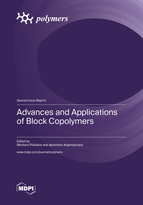Advances and Applications of Block Copolymers
A special issue of Polymers (ISSN 2073-4360). This special issue belongs to the section "Polymer Applications".
Deadline for manuscript submissions: closed (30 April 2023) | Viewed by 39075
Special Issue Editors
Interests: chemical modification reactions; preparation of composite materials; synthesis of hydrogels for wound healing
Special Issues, Collections and Topics in MDPI journals
Interests: living polymerization methods (anionic and living radical) of linear and non-linear polymers; molecular characterization in solution; self assembly of various types of polymers; structure/properties relationship; various modification reactions for polymers; superhydrophobic and super hydrophilic materials; conjugated polymers; nanopatterning of nanostructures
Special Issues, Collections and Topics in MDPI journals
Special Issue Information
Dear Colleagues,
The area of polymers is vast and evolving day by day, providing new insights into materials for advancing technologies and numerous applications. Polymerization techniques are diverse and can polymerize most monomers, leading to block copolymers with various properties that point to new, emerging applications.
In recent years, materials with self-healing properties, self-assembly, high biocompatibility, and responsiveness have led to smart materials that can be introduced in new technologies and applications.
Block copolymers (BCPs) are a class of materials that are constantly under evolution and advanced study. Numerous manuscripts are published every day, showing exciting results and advances with potential practical applications. Nevertheless, the area faces new challenges and problems that need to be solved—issues related to the synthetic procedure, scale-up, more biocompatible materials, and high technological applications. Many research groups worldwide are investigating BCPs from different perspectives and scientific interests, which signifies that polymers overall are a scientific area with continuous scientific, societal, and even economic impacts.
Any Special Issue including published review articles, research reports, and short communications on recent advances in BCPs will be received positively from the research community and will be considered a helpful tool for improving the overall scientific interest in block copolymers.
The keywords presented in this Special Issue are numerous and try to cover the majority of advances and applications of BCPs and other polymer combined materials. We encourage potential authors to illustrate BCP research advances that are well beyond the topics covered by these specific keywords.
Dr. Nikolaos Politakos
Prof. Dr. Apostolos Avgeropoulos
Guest Editors
Manuscript Submission Information
Manuscripts should be submitted online at www.mdpi.com by registering and logging in to this website. Once you are registered, click here to go to the submission form. Manuscripts can be submitted until the deadline. All submissions that pass pre-check are peer-reviewed. Accepted papers will be published continuously in the journal (as soon as accepted) and will be listed together on the special issue website. Research articles, review articles as well as short communications are invited. For planned papers, a title and short abstract (about 100 words) can be sent to the Editorial Office for announcement on this website.
Submitted manuscripts should not have been published previously, nor be under consideration for publication elsewhere (except conference proceedings papers). All manuscripts are thoroughly refereed through a single-blind peer-review process. A guide for authors and other relevant information for submission of manuscripts is available on the Instructions for Authors page. Polymers is an international peer-reviewed open access semimonthly journal published by MDPI.
Please visit the Instructions for Authors page before submitting a manuscript. The Article Processing Charge (APC) for publication in this open access journal is 2700 CHF (Swiss Francs). Submitted papers should be well formatted and use good English. Authors may use MDPI's English editing service prior to publication or during author revisions.
Keywords
- polymers
- copolymers
- block copolymers
- controlled synthesis
- anionic polymerization
- RAFT polymerization
- ATRP polymerization
- emulsion polymerization
- molecular characterization
- morphological characterization
- terpolymers
- hybrid materials
- polypeptides
- polymeric chimeras
- composite materials
- self-assembly
- polymer brushes
- biopolymers
- biocompatibility
- smart materials
- responsive properties
- hydrogels
- drug delivery
- computational chemistry
- structure–property relationship
- polymer nano/micro particles
- self-healing materials
- recyclability







